Mathematicians are often portrayed as geniuses who frantically scrabble equations onto blackboards while also having an odd personality. What if one of the most important mathematicians of the 20th century was able to answer some of math’s biggest puzzles while also dealing with something as debilitating as schizophrenia?
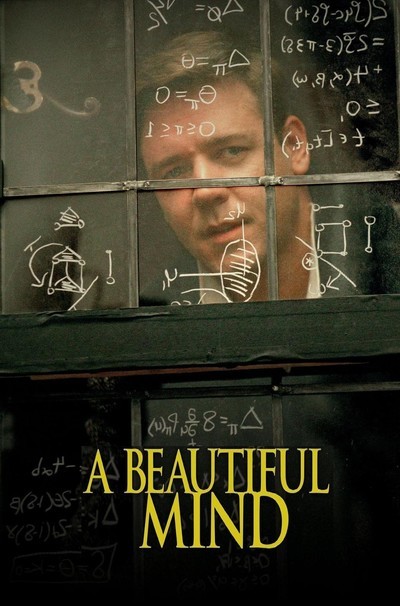
A movie poster showing John Nash (Russel Crowe) starring at the window where he has written his work.
Brief Overview: A Beautiful Mind is a movie that was produced in 2001 that is based on the life of the famous, schizophrenic mathematician, John Forbes Nash Jr., who is portrayed by Russel Crowe. This movie was inspired by the biographical novel “A Beautiful Mind” which was written by Sylvia Nasar. This movie creates a timeline of John Nash’s life that begins when he enters graduate school at Princeton to study mathematics where the early symptoms of schizophrenia begin to appear and continues into the later parts of his life such as when he won the Nobel Prize while still dealing with his disability. As the timeline progresses, so does the schizophrenia which is made worse by John’s supposed work pertaining to the military. By analyzing key scenes from the movie, we can get a glimpse into the life long struggles that someone with disability such as schizophrenia will go through.
What exactly is Schizophrenia? According to the National Institute of Mental Health, schizophrenia is a “chronic and severe mental disorder that affects how a person thinks, feels, and behaves” and causes people to seem as if they are “out of touch with reality”. There are multiple symptoms that are associated with schizophrenia, but some of the most common are hallucinations, delusional behavior and trouble focusing. There is no known cure or cause of schizophrenia, however, current research suggests that an imbalance of brain chemicals such as dopamine (National Institute of Mental Health).
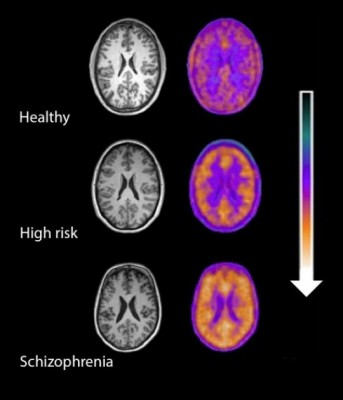
A brain scan that shows the difference in brain activity between a healthy individual and a schizophrenic individual.
Beginning Graduate School: The beginning of the movie helps establish John as a mysterious genius who seems to be socially off-putting but progresses to show how his schizophrenia impacts him. The movie begins with John introducing himself to other math graduate students, where he tries to make jokes with good intentions but ends up offending other students and leaving. He also offends the other graduate students by calling their work unoriginal and talking about how he will come with an “original” idea and solve it. After this confrontation, he heads back to his room, where he meets his roommate, Charles who is supposedly a graduate student studying English. This is the first time that John’s schizophrenic delusions become apparent to the audience as his room is made for one person.
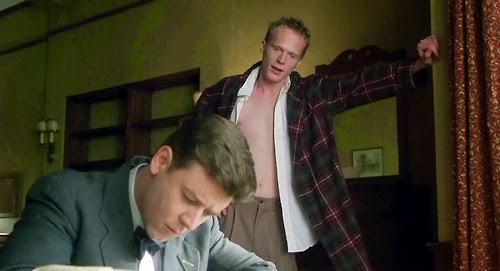
John Nash is sitting at his desk working while his roommate, Charles, looks over his shoulder and appears to be saying something to him. This is right after they move in.
Although the movie may not be a totally accurate description of John Nash’s disability, it does help paint an accurate representation of schizophrenia. In the movie, Nash’s schizophrenia sets in when he is in his early 20’s, and this is the typical age for when the symptoms of schizophrenia begin to manifest in people, however, the symptoms did not begin for Nash until he was in his early 30’s (Gil). Although his symptoms started late, they are still within the accepted range of when the onset of schizophrenia can begin, which helps portray the accuracy of the disability. The movie also takes advantage of symptoms such as delusions, reduced speaking/”flat effect”, and various cognitive symptoms such as poor executive functioning but these are all valid and common symptoms of schizophrenia as we know it (National Institute of Mental Health). These symptoms are put into effect in the beginning of the movie when Charles appears and also when John is talking to the other graduate students, although the cognitive symptoms do not appear until other key scenes in the move. He does not speak a lot and when he does it is not with a lot of emotion, which can be attributed to the onset of his disability. However, although the symptoms are accurate, John never had delusions figures such as Charles, he suffered mostly from auditory delusions. Overall, the beginning helps accurately introduce several key attributes of schizophrenia while also attempting to keep an accurate storyline.
Diagnosis of Paranoid Schizophrenia: The peak of John Nash’s schizophrenic delusions occurs while he is giving a speech about his current mathematical research. During this speech he sees men in suits in the aisles of the lecture room, who he thinks are soviet spies who have been ordered to capture him. As a result of this delusion, he runs out of the room and is chased by these supposed soviet spies. They capture him and it becomes apparent that these men are not soviet spies but are actually men sent to get him and bring him to a psychiatric hospital so he can get help with his disability. John’s delusions have made him believe that he is working for the Department of Defense under a mysterious government agent, William Parcher. He believes that he has been performing top secret soviet code breaking and he has been delivering this research to a top secret mailbox in sealed envelopes. In the hospital, his wife, Alicia Larde, reveals to him that there is no agent named William Parcher and none of his envelopes have ever been opened. She even goes on to show him that she was able to track down these top secret documents. John is ordered to under insulin shock therapy and take medication on the side to help cure his debilitating schizophrenia. These shock therapy sessions are very violent and required restraints to hold him down while watched by a team of nurses and doctors. However, his wife was able to prove to him that no William Parcher exists, which helps lead John to the depressing realization that he actually has paranoid schizophrenia.
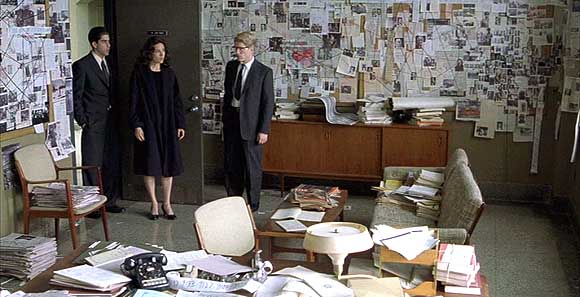
John’s wife and colleagues open the door and analyze John’s office. This was after John was sent to the psychiatric hospital. There are papers pinned to the walls and the office does not appear to be organized.
An analysis of the chain of events in this scene revealed that it incorporates a lot of accurate facts about schizophrenia but it also misrepresents somethings about Nash’s life and schizophrenia as well. The scene begins with John delusionally thinking that soviet spies are in the audience of his talk and does a good job of representing how much his disability had affected him. This scene shows just how much a disability like schizophrenia can affect a person and how it is not like other disabilities. When people think of schizophrenia, they make the mistake of thinking that an individual has multiple personalities, instead of realizing that a schizophrenic individual has trouble differentiating between real and imaginary things (ABC News). Throughout the movie, John’s personality never deviated much from where it started but his thought process does change as the movie progresses, which contributes to an accurate portrayal of schizophrenia. However, the movie does over exaggerate certain symptoms that are often associated with schizophrenia. Most individuals who have schizophrenia tend to heard voices rather than see hallucinations and these voices are what lead to the delusions (ABC News). In fact, John Nash actually never saw these hallucinations. However, these hallucinations give the audience insight into what it is like to struggle with schizophrenia so they do serve a purpose in the movie.
Another key event in this scene takes place when John is in the psychiatric hospital. It is in this scene where the audience is exposed to the truly cruel techniques that were used to cure schizophrenia. The psychiatric hospital is all white, in every room and hallway and gives the audience an unsettling feeling about the place. This scene takes place in the 1950’s, and is reflected in the treatments that were used. It was during this time that new treatments were being developed to attempt to cure schizophrenia, which is shown when John is forced to undergo insulin shock therapy a couple times a week. The results of this treatment were horrible and eventually were discredited as anti-psychotic drugs were introduced (ABC News). The introduction of anti-psychotic drugs plays a very important role in allowing schizophrenic people to lead normal lives. Also during this scene, the movie makes it seem as if people with schizophrenia only need to spend a short amount of time in the hospital and get medication then return back to normal life. This is also untrue as even John Nash was troubled for multiple decades by his disability and during this extended period of time he could not do any work. Overall, this chain of events show a turning point in the movie and help give insight into not only John Nash’s life but also anyone who deals with a schizophrenia.
Relapse: After being released from the psychiatric hospital, John tried to resume his normal life and his mathematical research. However, he was required to take medication to help treat the symptoms of his
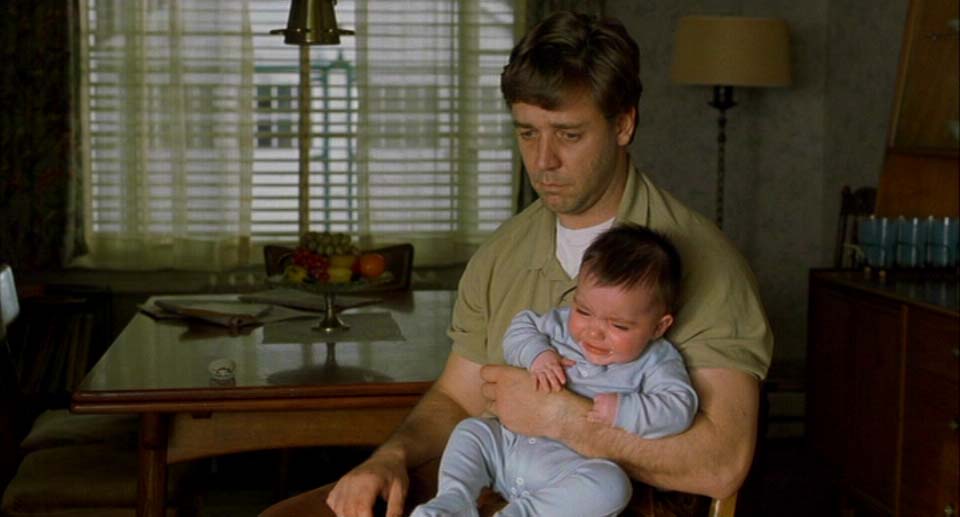
5. John sits at a table as he prepares to bathe his baby. He does not look healthy or happy and it appears that his baby is crying.
disability and this presented him with a problem. When taking his medication, he claims that he was not able to think freely and thus it caused him to make little or no progress with his research. As a result, John stops taking his medication so that he can think better. This costs him greatly as shortly after he stops taking his medication, he becomes delusional. John is giving his baby a bath one day after his wife went out into the backyard to hang up laundry. She notices that something is off then sprints back inside to find their baby almost drowning while John is having a schizophrenic episode and telling her that Charles was watching the baby. She rescues the baby as while she watches John have an argument what seems like nothing but is actually with Charles and William Parcher. During this supposed argument, Parcher pulls a gun on John’s wife, which causes John to try to tackle Parcher and save his wife since he thinks that all of this is real. When he runs at Parcher, he actually runs at his wife and knocks her over. As she attempts to leave the house, John runs out and explains that he has realized that none of what just happened was real, which shows that he recognized he was having a delusion. This is where the mood of the movie changes as John has come to terms that he may or may not be able to defeat his schizophrenia.
This scene presents another opportunity to let the audience know how John is feeling. After leaving the psychiatric hospital, John has to take medicine that helps prevent the delusions from occurring however, this impedes his thinking so he stops taking the pills, which almost has disastrous consequences. This scene specifically does a good job of appealing to the emotions of the audience because almost everyone has taken medicine or been sick to the point where it affects how they think, which often times leads to people not taking their medication. These drugs have a mild effect profile that help decrease the delusions, yet people still relapse (Gil). These drugs affect how people think and feel so as a result people stop taking them. This shows how much more research needs to be done in order to understand schizophrenia more in order to prevent more relapses. This leads to the next point though, which is that medication may be the best solution but the best solution may not be able to solve everything. According to ABC News, “The movie’s message that medications are an important part of treatment, although they aren’t a cure-all, is an accurate message” (ABC News). The movie portrays a very real example of how medication may help although there are still limitations to what it can do.
Learning to live with Paranoid Schizophrenia: After his relapse, John is faced with the decision that he will have to return to the psychiatric hospital and take medicine, which will hinder his research or he can learn to deal with his disability so that he can do what he loves: math. He is able to return to Princeton and agrees to work out of the library. While starting to work at Princeton, he still had to learn to deal with his delusions in a new environment, which proved to be difficult but manageable. It is during this period of John Nash’s life that he was able to resume his research and when he wins him the Nobel Prize in economics for work that he did for his dissertation. The scenes still show John’s delusions such as Parcher and Charles but he knows to not acknowledge them. This portrays John as being able to rationalize his disability and that is how he “healed” himself.

John is sitting at a round table being gifted pens by other members of the Princeton faculty. There are six pens on the table as it appears that there are more to come. This is a very prestigious event in the movie.
This scene is one of the most important in the movie, if not the most important, because it helps show much we do not know about schizophrenia. By analyzing this scene, it shows how the movie was able to represent certain things that we have yet to learn about schizophrenia. The movie portrays John as being able to simply not pay attention to his delusions just by rationalizing them and without the use of medication, but this may actually be done to external factors in his life. A supportive environment and aging can lead to better outcomes for schizophrenic individuals (Rettner). This is portrayed in the movie as John’s wife and colleagues are all very supportive and even help get him a professorship at Princeton. So while John may attribute his remission to rationalization, it may be due to these factors. Recent studies have shown that up to 60% of individuals with schizophrenia can achieve remission through the use of treatment, however, no one knows how remission occurs (Rettner). This statistic shows how much research lays ahead but it also helps show how much progress has been made since John Nash was originally diagnosed with paranoid schizophrenia.
Conclusion and Final Thoughts: After watching this movie, analyzing the details of key scenes, and reading multiple online reviews and even reviews from the real John Forbes Nash Jr., I have come to the conclusion that this movie is able to accurately portray the intricacies of schizophrenia to the audience. Although the scenes may not always accurately depict what specifically happened to John Nash, they still portray ideas and facts about schizophrenia. Russell Crowe’s acting was great and helped enlightened the audience about what it is like to go through life with schizophrenia. However, I think John Nash’s case of schizophrenia is very unusual and deviates greatly from what the average schizophrenic individual will encounter. John was able to somehow put his schizophrenia into remission without the use of medication which seems to be something that most experts have not heard of. The movie also incorporated all the correct views and science that was known in the 1950’s and 1960’s that helps give the audience an authentic view into what was known about a mental disability like schizophrenia. Overall, I think this movie is a great and accurate example of what is it like to live with schizophrenia and has the ability to educate individuals about what is known about this disability.
Citations
- ABC News. “How Realistic Is ‘A Beautiful Mind’?” ABC News, 17 Jan. 2016, abcnews.go.com/GMA/DrJohnson/story?id=126426&page=1. Accessed 1 Dec. 2016.
- “a-beautiful-mind-pen-scene.jpg.” Jarvis City, jarviscity.com/2014/07/30/pen-movie-scenes/. Accessed 30 Nov. 2016.
- “abeautifulmindrusselcrowepaulbettany.” www.oscarfavorite.com/2014/08/a-beautiful-mind.html#.WD-RQaLx7Vo. Accessed 30 Nov. 2016.
- “abm34.jpg.” Blog Cabins, blogcabins.blogspot.com/2010/09/30-days-of-crazy-beautiful-mind.html. Accessed 30 Nov. 2016.
- “A Beautiful Mind.” Rogerebert.com, Ebert Digital LLC, static.rogerebert.com/uploads/movie/movie_poster/a-beautiful-mind-2001/large_v1WdKm9qQPBfhoHanBP5XxzIBDU.jpg. Accessed 30 Nov. 2016.
- Bloomfield, Peter S. “microglial.jpg.” Bipolar Network News, bipolarnews.org/?p=3583. Accessed 30 Nov. 2016.
- Gil, Robert. “Beautiful Minds: A movie raises questions about schizophrenia.” News From Columbia Health Sciences, Columbia University, 11 Feb. 2002, www.cumc.columbia.edu/publications/in-vivo/Vol1_Iss3_feb11_02/pov.html. Accessed 30 Nov. 2016.
- “JohnNash.jpg.” Wbur, www.wbur.org/hereandnow/2015/05/25/john-nash-dies. Accessed 30 Nov. 20176.
- Moody, Tom. “beautiful_mind.jpg.” www.digitalmediatree.com/tommoody/pageback/27553/. Accessed 30 Nov. 2016.
- The National Institute of Mental Health. “Schizophrenia.” National Institute of Health, www.nimh.nih.gov/health/topics/schizophrenia/index.shtml. Accessed 26 Nov. 2016.
- Rettner, Rachael. “‘Beautiful Mind’ John Nash’s Schizophrenia ‘Disappeared’ as He Aged.” Scientific American, 4 June 2015, www.scientificamerican.com/article/beautiful-mind-john-nash-s-schizophrenia-disappeared-as-he-aged/. Accessed 1 Dec. 2016.